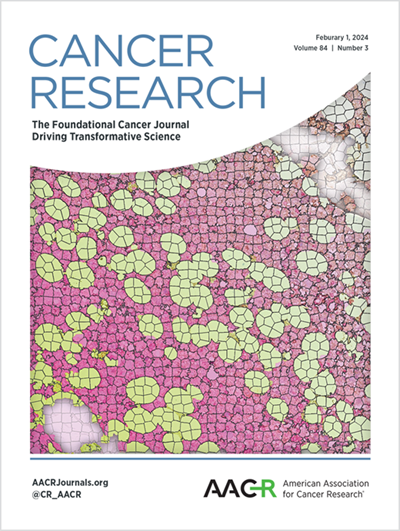Pancreatic Neuroendocrine Tumors Secrete Apolipoprotein E to Induce Tip Endothelial Cells That Remodel the Tumor–Stroma Ratio and Promote Cancer Progression
IF 12.5
1区 医学
Q1 ONCOLOGY
引用次数: 0
Abstract
A low tumor–stroma ratio (TSR) in pancreatic neuroendocrine tumors (pNET) is associated with a significantly poorer patient prognosis. Although the tumor stroma represents an attractive therapeutic target, recent clinical trials have not been successful. In this study, we aimed to dissect the mechanisms regulating the tumor microenvironment in low TSR pNETs to identify potential therapeutic targets. Laser capture microdissection analysis revealed that stroma-rich tumors excessively secrete apolipoprotein E (ApoE) relative to stroma-poor tumors, with the specific receptor SCARB1 predominantly located on endothelial cells (EC). Single-cell analysis revealed a greater proportion of endothelial tip cells (TipEC) in stroma-rich tumors due to transformation of other types of ECs into TipECs induced by cancer cell–derived ApoE. The TipECs played crucial roles in driving pNET progression by facilitating cancer-associated fibroblast recruitment and remodeling the TSR. Mechanistically, ApoE promoted the uptake of palmitic acid by ECs and subsequently activated the transcription factor ATF6 to upregulate the PDGF pathway. Screening of six commonly used drugs for pNETs in vivo revealed that treatment with mTOR inhibitors suppressed the secretion of ApoE by cancer cells, blocking the subsequent effects of ApoE on the stromal microenvironment. Importantly, mTOR inhibitors synergistically enhanced the antitumor effects of stroma-targeting PEGPH20 in vivo in pNETs. Overall, this study revealed that cancer cell–derived ApoE could induce TipECs to remodel the TSR and that mTOR inhibitors could increase the efficacy of stroma-targeting therapies. Significance: Secretion of ApoE by pancreatic neuroendocrine tumor cells engenders a stroma-rich microenvironment, which can be reversed with mTOR inhibitors as part of combination strategies targeting the tumor stroma.胰腺神经内分泌肿瘤分泌载脂蛋白E诱导尖端内皮细胞重塑肿瘤-间质比例并促进肿瘤进展
胰腺神经内分泌肿瘤(pNET)的肿瘤间质比(TSR)低与患者预后明显较差相关。虽然肿瘤基质是一个有吸引力的治疗靶点,但最近的临床试验尚未成功。在本研究中,我们旨在剖析低TSR pNETs中调节肿瘤微环境的机制,以确定潜在的治疗靶点。激光捕获显微解剖分析显示,相对于基质贫乏的肿瘤,基质丰富的肿瘤过度分泌载脂蛋白E (ApoE),其特异性受体SCARB1主要位于内皮细胞(EC)上。单细胞分析显示,由于癌细胞来源的ApoE诱导其他类型的内皮尖细胞转化为TipEC,因此在富含基质的肿瘤中内皮尖细胞(TipEC)的比例更高。TipECs通过促进癌症相关成纤维细胞募集和重塑TSR,在推动pNET进展中发挥了关键作用。机制上,ApoE促进ECs对棕榈酸的摄取,随后激活转录因子ATF6上调PDGF通路。在体内筛选6种常用的pNETs药物发现,mTOR抑制剂可抑制癌细胞分泌ApoE,阻断ApoE对间质微环境的后续作用。重要的是,mTOR抑制剂在pNETs中协同增强了基质靶向PEGPH20的抗肿瘤作用。总的来说,本研究揭示了癌细胞来源的ApoE可以诱导TipECs重塑TSR, mTOR抑制剂可以提高基质靶向治疗的疗效。意义:胰腺神经内分泌肿瘤细胞分泌ApoE可形成富含基质的微环境,作为靶向肿瘤基质的联合策略的一部分,mTOR抑制剂可逆转这一微环境。
本文章由计算机程序翻译,如有差异,请以英文原文为准。
求助全文
约1分钟内获得全文
求助全文
来源期刊

Cancer research
医学-肿瘤学
CiteScore
16.10
自引率
0.90%
发文量
7677
审稿时长
2.5 months
期刊介绍:
Cancer Research, published by the American Association for Cancer Research (AACR), is a journal that focuses on impactful original studies, reviews, and opinion pieces relevant to the broad cancer research community. Manuscripts that present conceptual or technological advances leading to insights into cancer biology are particularly sought after. The journal also places emphasis on convergence science, which involves bridging multiple distinct areas of cancer research.
With primary subsections including Cancer Biology, Cancer Immunology, Cancer Metabolism and Molecular Mechanisms, Translational Cancer Biology, Cancer Landscapes, and Convergence Science, Cancer Research has a comprehensive scope. It is published twice a month and has one volume per year, with a print ISSN of 0008-5472 and an online ISSN of 1538-7445.
Cancer Research is abstracted and/or indexed in various databases and platforms, including BIOSIS Previews (R) Database, MEDLINE, Current Contents/Life Sciences, Current Contents/Clinical Medicine, Science Citation Index, Scopus, and Web of Science.
 求助内容:
求助内容: 应助结果提醒方式:
应助结果提醒方式:


